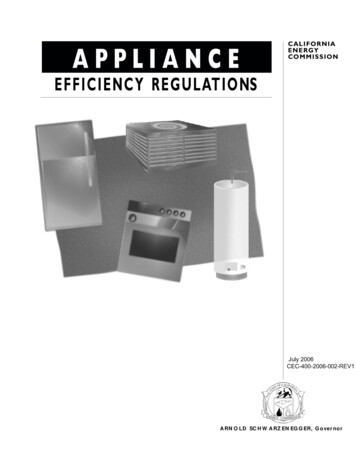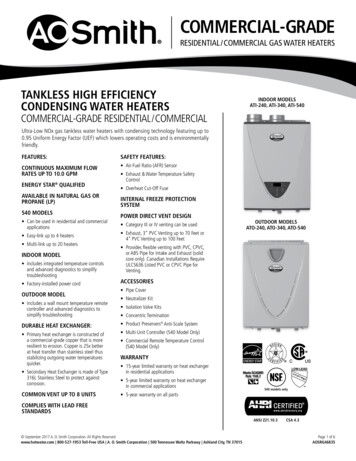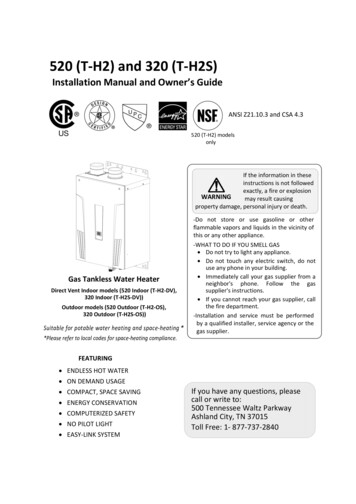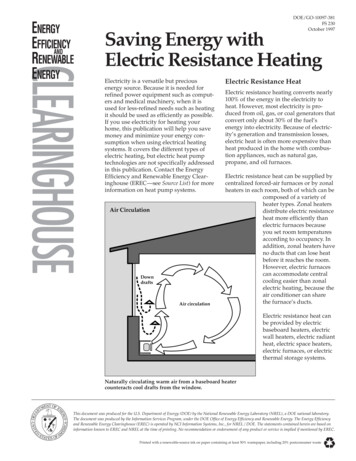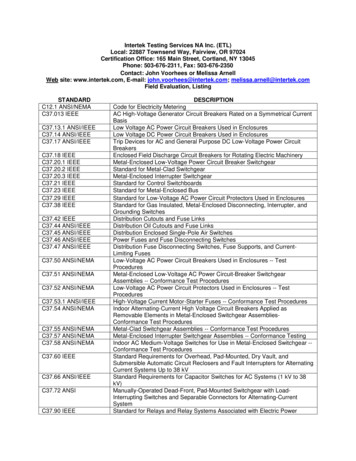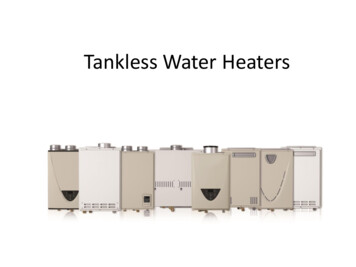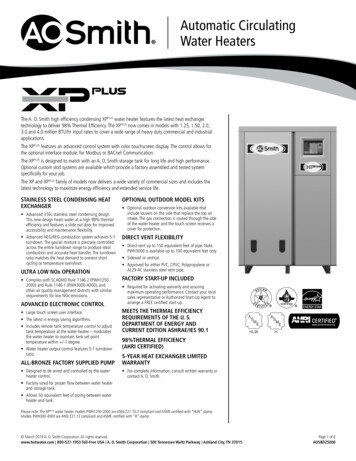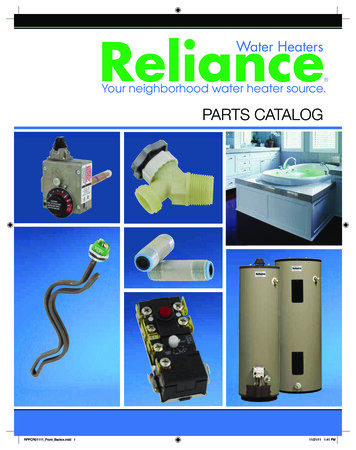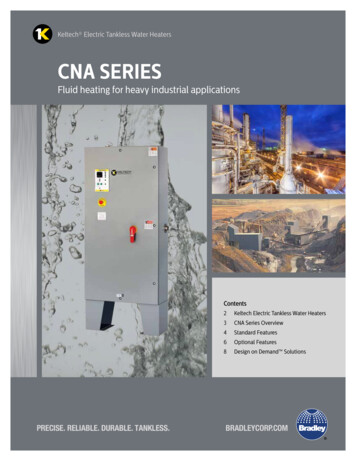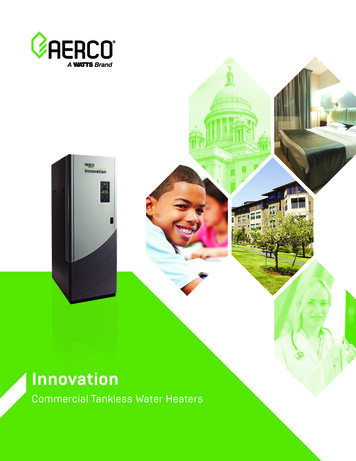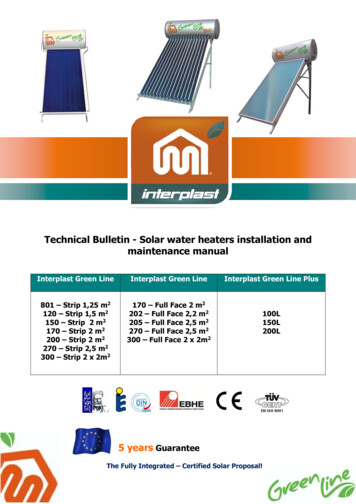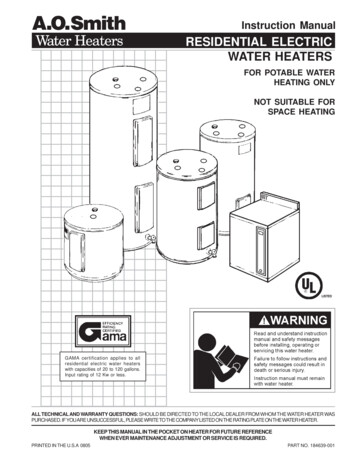
Transcription
Instruction ManualRESIDENTIAL ELECTRICWATER HEATERSFOR POTABLE WATERHEATING ONLYNOT SUITABLE FORSPACE HEATINGLISTEDGAMA certification applies to allresidential electric water heaterswith capacities of 20 to 120 gallons.Input rating of 12 Kw or less.ALL TECHNICAL AND WARRANTY QUESTIONS: SHOULD BE DIRECTED TO THE LOCAL DEALER FROM WHOM THE WATER HEATER WASPURCHASED. IF YOU ARE UNSUCCESSFUL, PLEASE WRITE TO THE COMPANY LISTED ON THE RATING PLATE ON THE WATER HEATER.KEEP THIS MANUAL IN THE POCKET ON HEATER FOR FUTURE REFERENCEWHEN EVER MAINTENANCE ADJUSTMENT OR SERVICE IS REQUIRED.PRINTED IN THE U.S.A 08051PART NO. 184639-001
SAFE INSTALLATION, USE AND SERVICEYour safety and the safety of others is extremely important in the installation, use and servicing of this water heater.Many safety-related messages and instructions have been provided in this manual and on your own water heater to warn you andothers of a potential injury hazard. Read and obey all safety messages and instructions throughout this manual. It is veryimportant that the meaning of each safety message is understood by you and others who install, use or service this water heater.This is the safety alert symbol. It is used to alert youto potential personal injury hazards. Obey all safetymessages that follow this symbol to avoid possibleinjury or death.DANGERDANGER indicates an imminentlyhazardous situation which, if not avoided,could result in death or injury.WARNINGWARNING indicates a potentially hazardoussituation which, if not avoided, could resultin death or injury.CAUTIONCAUTION indicates a potentially hazardoussituation which, if not avoided, may resultin minor or moderate injury.CAUTIONCAUTION used without the safety alertsymbol indicates a potentially hazardoussituation which, if not avoided, could resultin property damage.All safety messages will generally tell you about the type of hazard, what can happen if you do not follow the safety message andhow to avoid the risk of injury.IMPORTANT DEFINITIONS Qualified Installer: A qualified installer must have ability equivalent to a licensed tradesman in the fields of plumbing, and electrical installationof these appliances. This would include a thorough understanding of the requirements of the National Electrical Code and applicable localelectrical and plumbing codes (and tools necessary to confirm proper installation and operation of the water heater) as they relate tothe installation of electric water heaters. The qualified installer must have a thorough understanding of the water heaterInstruction Manual. Service Agency: A service agency also must have ability equivalent to a licensed tradesman in the fields of plumbing, and electrical installationof these appliances. This would include a thorough understanding of the requirements of the National Electrical Code and applicable localelectrical and plumbing codes (and tools necessary to confirm proper installation and operation of the water heater) as they relate tothe installation of electric water heaters. The service agency must have a thorough understanding of the water heaterInstruction Manual.2
GENERAL SAFETYTABLE OF CONTENTSSAFE INSTALLATION, USE AND SERVICE . 2GENERAL SAFETY . 3TABLE OF CONTENTS . 3INTRODUCTION . 4Preparing for the New Installation . 4NOTES . 4TYPICAL INSTALLATION . 5WIRING DIAGRAMS . 6MIXING VALVE USAGE . 7LOCATING THE NEW WATER HEATER . 8Facts to Consider About Location . 8Insulation Blankets . 8INSTALLING THE NEW WATER HEATER . 8Water Piping . 8-9Temperature-Pressure Relief Valve . 9-10Filling the Water Heater . 10T&P Valve and Pipe Insulation (Selected Models) . 10TEMPERATURE REGULATION . 11Temperature Adjustment . 11FOR YOUR INFORMATION . 12Thermal Expansion . 12Strange Sounds . 12Operational Conditions . 12Smelly Water . 12“Air” in Hot Water Faucets . 12High Water Temperature Shut Off System . 12PERIODIC MAINTENANCE . 12Anode Rod Inspection . 12-13Temperature-Pressure Relief Valve Operation . 13Draining . 13Drain Valve Washer Replacement . 13Service . 13LEAKAGE CHECKPOINTS . 14REPAIR PARTS LIST . 15TROUBLESHOOTING . 16WARRANTY . 17-183
INTRODUCTIONThank You for purchasing this water heater. Properly installed andmaintained, it should give you years of trouble free service.2. The installation must conform with these instructions and the localcode authority having jurisdiction and the requirements of the powercompany. In the absence of code requirements follow NFPA-70(latest edition). The National Electric Code which may be orderedfrom: National Fire Protection Association, 1 Batterymarch Park,Quincy, MA 02269.Abbreviations Found In This Instruction Manual: ANSI - American National Standards Institute ASME - American Society of Mechanical Engineers GAMA - Gas Appliance Manufacturer’s Association NEC - National Electric Code NFPA - National Fire Protection Association UL - Underwriters Laboratory3. If after reading this manual you have any questions or do notunderstand any portion of the instructions, call the local utility or themanufacturer whose name appears on the rating plate.4. Carefully plan the place where you are going to put the water heater.INSTALLATION OR SERVICE OF THIS WATER HEATER REQUIRESABILITY EQUIVALENT TO THAT OF A LICENSED TRADESMAN INTHE FIELD INVOLVED. PLUMBING AND ELECTRICAL WORK AREREQUIRED.PREPARING FOR THE INSTALLATION1. Read the “General Safety” section of this manual first and then theentire manual carefully. If you don’t follow the safety rules, thewater heater will not operate properly. It could cause DEATH,SERIOUS BODILY INJURYAND/OR PROPERTY DAMAGE.Examine the location to ensure the water heater complies with the“Facts to Consider About the Location” section in this manual.5. For California installation this water heater must be braced, anchored,or strapped to avoid falling or moving during an earthquake. Seeinstructions for correct installation procedures. Instructions may beobtained from California Office of the State Architect, 400 P Street,Sacramento, CA 95814.This manual contains instructions for the installation, operation, andmaintenance of the electric water heater. It also contains warningsthroughout the manual that you must read and be aware of. Allwarnings and all instructions are essential to the proper operation ofthe water heater and your safety. Since we cannot put everythingon the first few pages, READ THE ENTIRE MANUAL BEFOREATTEMPTING TO INSTALL OR OPERATE THE WATER HEATER.6. Massachusetts Code requires this water heater to be installed inaccordance with Massachusetts 248-CMR 2.00: State Plumbing Codeand 248-CMR 5.00.NOTES4
TYPICAL INSTALLATIONLOWBOYSUPRIGHTSCOMPACTSTABLE TOPSINSTALL SUITABLE DRAIN PANS UNDER HEATERSTO PREVENT DAMAGE DUE TO LEAKAGE. REFERTO WATER HEATER LOCATION ON PAGE 8.INSTALL VACUUM RELIEF IN COLD WATERINLET LINE AS REQUIRED BY LOCAL CODES.INSTALL THERMAL EXPANSION TANK OR DEVICEIF WATER HEATER IS INSTALLED IN A CLOSEDWATER SYSTEM.FIGURE 1.5
WIRING DIAGRAMSTURN OFF THE HEATER ELECTRICAL SUPPLY BEFORE SERVICING ANY ELECTRICAL COMPONENTS.C-2A-9TWO WIRE CIRCUIT FOR SINGLEELEMENT HEATERS EQUIPPEDWITH HIGH LIMIT CONTROL240 VOLT “OFF PEAK” NON-SIMULTANEOUSOPERATION BOTTOM ELEMENT ON SEPARATETIME CLOCK OR “OFF PEAK” METERS-1THREE WIRE CIRCUIT FORELECTRIC CO. CO-OPPROGRAMSA-6TWO WIRE CIRCUIT FORNON-SIMULTANEOUS OPERATION,HAS SINGLE HIGH LIMIT CONTROLFIGURE 2.6
MIXING VALVE USAGEFIGURE 3.Water (Potable) Heating: All models are considered suitable forwater (potable) heating only.HOTTER WATER CAN SCALD:Water heaters are intended to produce hot water. Water heated to atemperature which will satisfy space heating, clothes washing, dishwashing, and other sanitizing needs can scald and permanently injureyou upon contact. Some people are more likely to be permanentlyinjured by hot water than others. These include the elderly, children, theinfirm, or physically/mentally handicapped. If anyone using hot water inyour home fits into one of these groups or if there is a local code or statelaw requiring a certain temperature water at the hot water tap, then youmust take special precautions. In addition to using the lowest possibletemperature setting that satisfies your hot water needs, a means suchas a *mixing valve, shall be used at the hot water taps used by thesepeople or at the water heater. Mixing valves are available local plumbingcontractor. Consult a Qualified Installer or Service Agency. Followmixing valve manufacturer’s instructions for installation of the valves.Before changing the factory setting on the thermostat, read the“Temperature Regulation” section in this manual.7
LOCATING THE NEW WATER HEATERWater heater life depends upon water quality, water pressure and theenvironment in which the water heater is installed. Water heaters aresometimes installed in locations where leakage may result in propertydamage, even with the use of a drain pan piped to a drain. However,unanticipated damage can be reduced or prevented by a leak detectoror water shut-off device used in conjunction with a piped drain pan.These devices are available from some plumbing supply wholesalersand retailers, and detect and react to leakage in various ways:FACTS TO CONSIDER ABOUT THE LOCATION Carefully choose an indoor location for the new water heater, becausethe placement is a very important consideration for the safety of theoccupants in the building and for the most economical use of theappliance. Whether replacing an old water heater or putting the water heater in anew location, the following critical points must be observed:Sensors mounted in the drain pan that trigger an alarm or turn offthe incoming water to the water heater when leakage is detected.Sensors mounted in the drain pan that turn off the water supply tothe entire home when water is detected in the drain pan.Water supply shut-off devices that activate based on the waterpressure differential between the cold water and hot water pipesconnected to the water heater.Devices that will turn off the gas supply to a gas water heater whileat the same time shutting off its water supply.INSULATION BLANKETS1. Select a location indoors as close as practical or centralizedto the water piping system as possible. The water heatershould be located in an area not subject to freezingtemperatures.Insulation blankets are available to the general public for external useon electric water heaters but are not necessary with this product. Thepurpose of an insulation blanket is to reduce the standby heat lossencountered with storage tank heaters. Your water heater meets orexceeds the National Appliance Energy Conversation Act standardswith respect to insulation and standby loss requirements, making aninsulation blanket unnecessary.2. Selected location must provide adequate clearances (4”) for servicingparts such as the thermostats, drain valve and relief valve. Adequateclearance for servicing this appliance should be considered beforeinstallation, such as changing the anodes, etc.Should you choose to apply an insulation blanket to this heater, youshould follow these instructions below. Failure to follow theseinstructions can result in fire, serious personal injury, or death.Installation of the water heater must be accomplished in such a mannerthat if the tank or any connections should leak, the flow will not causedamage to the structure. For this reason, it is not advisable to install thewater heater in an attic or upper floor. When such locations cannot beavoided, a suitable drain pan should be installed under the water heater.Drain pans are available from your local plumbing contractor. Such adrain pan must have a minimum length and width of at least 2 inches(51 mm) greater that the water heater dimensions and must be piped toan adequate drain. Do not cover the temperature and pressure relief (T & P) valve withan insulation blanket. Do not cover the instruction manual. Keep it on the side of thewater heater or nearby for future reference. Do obtain new warning and instruction labels for placement on theblanket directly over the existing labels.INSTALLING THE NEW WATER HEATERinjured by hot water than others. These include the elderly, children,the infirm, or physically/mentally handicapped. If anyone using hotwater in your home fits into one of these groups or if there is a localcode or state law requiring a certain temperature water at the hotwater tap, then you must take special precautions. In addition to usingthe lowest possible temperature setting that satisfies your hot waterneeds, a means such as a *mixing valve, shall be used at the hot watertaps used by these people or at the water heater. Valves for reducingpoint of use temperature by mixing cold and hot water are also available.WATER PIPINGConsult a Qualified Installer or Service Agency. Follow manufacturer’sinstructions for installation of the valves. Before changing the factorysetting on the thermostat, read the “Temperature Regulation” section inthis manual.HOTTER WATER CAN SCALD:Water heaters are intended to produce hot water. Water heated to atemperature which will satisfy space heating, clothes washing, dishwashing, cleaning and other sanitizing needs can scald and permanentlyinjure you upon contact. Some people are more likely to be permanently8
TEMPERATURE-PRESSURE RELIEF VALVEThis water heater shall not be connected to any heating systems orcomponent(s) used with a non-potable water heating appliance.Toxic chemicals, such as those used for boiler treatment shall not beintroduced into this system.Water supply systems may, because of such events as high linepressure, frequent cut-offs, the effects of water hammer amongothers, have installed devices such as pressure reducing valves, checkvalves, back flow preventers, etc. to control these types of problems.When these devices are not equipped with an internal by-pass, and noother measures are taken, the devices cause the water system to beclosed. As water is heated, it expands (thermal expansion) and closedsystems do not allow for the expansion of heated water.The water within the water heater tank expands as it is heated andincreases the pressure of the water system. If the relieving point ofthe water heater’s temperature-pressure relief valve is reached, thevalve will relieve the excess pressure. The temperature-pressurerelief valve is not intended for the constant relief of thermalexpansion. This is an unacceptable condition and must be corrected.It is recommended that any devices installed which could create aclosed system have a by-pass and/or the system have an expansiontank or device to relieve the pressure built by thermal expansion in thewater system. Expansion tanks are available for ordering through alocal plumbing contractor. Contact the local water supplier and/or aservice agency for assistance in controlling these situations.This heater is provided with a properly certified combinationtemperature - pressure relief valve by the manufacturer.NOTE: To protect against untimely corrosion of hot and coldwater fittings, it is strongly recommended that di-electricunions or couplings be installed on this water heater whenconnected to copper pipe.The valve is certified by a nationally recognized testing laboratory thatmaintains periodic inspection of production of listed equipment ofmaterials as meeting the requirements for Relief Valves and AutomaticGas Shut-off Devices for Hot Water Supply Systems, ANSI Z21.22 CSA 4.4, and the code requirements of ASME.If replaced, the valve must meet the requirements of local codes, butnot less than a combination temperature and pressure relief valvecertified as indicated in the above paragraph.The valve must be marked with a maximum set pressure not to exceedthe marked hydrostatic working pressure of the water heater(150 psi 1,035 kPa) and a discharge capacity not less than the waterheater input rate as shown on the model rating plate.For safe operation of the water heater, the relief valve must not beremoved from its designated opening nor plugged.The temperature-pressure relief valve must be installed directly intothe fitting of the water heater designed for the relief valve. Position thevalve downward and provide tubing so that any discharge will exitonly within 6 inches (153 mm) above, or at any distance below thestructural floor. Be certain that no contact is made with any live electricalpart. The discharge opening must not be blocked or reduced in sizeunder any circumstances. Excessive length, over 30 feet (9.14 m), oruse of more than four elbows can cause restriction and reduce thedischarge capacity of the valve.FIGURE 4.Figure 4 shows the typical attachment of the water piping to the waterheater. The water heater is equipped with 3/4 inch NPT waterconnections.No valve or other obstruction is to be placed between the relief valveand the tank. Do not connect tubing directly to discharge drain unlessa 6 inch air gap is provided. To prevent bodily injury, hazard to life, orproperty damage, the relief valve must be allowed to discharge waterin quantities should circumstances demand. If the discharge pipe is notconnected to a drain or other suitable means, the water flow maycause property damage.NOTE: If using copper tubing, solder tubing to an adapterbefore attaching the adapter to the cold water inlet connection.Do not solder the cold water supply line directly to the coldwater inlet, it will harm the dip tube and damage the tank.9
in front of or around the outlet of the temperature-pressure relief valvedischarge line, and (2) the water manually discharged will not causeany bodily injury or property damage because the water may beextremely hot.If after manually operating the valve, it fails to completely reset andcontinues to release water, immediately close the cold water inlet tothe water heater, follow the draining instructions, and replace thetemperature-pressure relief valve with a new one.The Discharge Pipe:FILLING THE WATER HEATER Shall not be smaller in size than the outlet pipe size of the valve, orhave any reducing couplings or other restrictions. Shall not be plugged or blocked. Shall be of material listed for hot water distribution. Shall be installed so as to allow complete drainage of both thetemperature-pressure relief valve, and the discharge pipe. Shall terminate at an adequate drain. Shall not have any valve between the relief valve and tank.Never use this water heater unless it is completely full of water. Toprevent damage to the tank, the tank must be filled with water. Watermust flow from the hot water faucet before turning “ON” electricalsupply to the water heater.To fill the water heater with water:1. Close the water heater drain valve by turning the handle to the right(clockwise). The drain valve is on the lower front of the waterheater.2. Open the cold water supply valve to the water heater.NOTE: The cold water supply valve must be left open whenthe water heater is in use.3. To insure complete filling of the tank, allow air to exit by opening thenearest hot water faucet. Allow water to run until a constant flowis obtained. This will let air out of the water heater and the piping.4. Check all water piping and connections for leaks. Repair as needed.PIPE INSULATIONFIGURE 5.FIGURE 6.T&P VALVE and PIPE INSULATION(On Selected Models)Remove insulation for T&P Valve and pipe connections from carton.Fit pipe insulation over the incoming cold water line and the hot waterline. Make sure that the insulation is against the top cover of the heater.Fit T&P Valve insulation over valve. Make sure that the insulation doesnot interfere with the lever or outlet of the T&P valve.The temperature-pressure relief valve must be manually operated atleast once a year. Caution should be taken to ensure that (1) no one isSecure all insulation using tape.10
TEMPERATURE REGULATIONKEEPING THE THERMOSTAT SETTING AT 120 F WILL REDUCE THERISK OF SCALDS.Due to the nature of the typical water heater, the water temperature incertain situations may vary up to 30 F (16.7 C) higher or lower at thepoint of use such as, bathtubs, showers, sink, etc.Figure 7 shows the approximate time-to-burn relationship for normaladult skin. The thermostats on your water heater have a linearrelationship between degrees of angular rotation and the correspondingchange in temperature. Thus rotating the temperature adjustmentindicator 30 angular degrees will result in a 10 degree Fahrenheitchange in water temperature.Any water heater’s intended purpose is to heat water. Hot water isneeded for cleansing, cleaning, and sanitizing (bodies, dishes, clothing).Untempered hot water can present a scald hazard. Depending on thetime element, and the people involved (adults, children, elderly, infirm,etc.) scalding may occur at different temperatures.TEMPERATURE ADJUSTMENTTo change the temperature setting:HOTTER WATER CAN SCALD: Water heaters are intended to producehot water. Water heated to a temperature which will satisfy spaceheating, clothes washing, dish washing, and other sanitizing needscan scald and permanently injure you upon contact. Some people aremore likely to be permanently injured by hot water than others. Theseinclude the elderly, children, the infirm, or physically/mentallyhandicapped. If anyone using hot water in your home fits into one ofthese groups or if there is a local code or state law requiring a certaintemperature water at the hot water tap, then you must take specialprecautions. In addition to using the lowest possible temperature settingthat satisfies your hot water needs, a means such as a mixing valve,shall be used at the hot water taps used by these people or at thewater heater. Mixing valves are available from your local plumbingcontractor. Follow manufacturer’s instructions for installation of thevalves. Before changing the factory setting on the thermostat, readthe “Temperature Regulation” section in this manual.1. Turn off the heater electrical supply. Do not attempt to adjustthermostat with power on.2. Remove the thermostat access panels and covers from thethermostats. Do not remove the plastic personnel protectors coveringthe thermostats.3. Using a flat tip screwdriver, rotate the adjustment knob to the desiredtemperature setting.4. Replace the covers and access panels and turn on heater electricalsupply.THIS WATER HEATER IS EQUIPPED WITH AN ADJUSTABLETHERMOSTAT TO CONTROL WATER TEMPERATURE. HOTWATER TEMPERATURES DESIRED FOR AUTOMATICDISHWASHER AND LAUNDRY USE CAN CAUSE SCALDSRESULTING IN SERIOUS PERSONAL INJURY AND/OR DEATH.THE TEMPERATURE AT WHICH INJURY OCCURS VARIES WITH THEPERSON’S AGE AND THE TIME OF THE EXPOSURE. THE SLOWERRESPONSE TIME OF CHILDREN, AGED OR DISABLED PERSONSINCREASES THE HAZARDS TO THEM. NEVER ALLOW SMALLCHILDREN TO USE A HOT WATER TAP, OR TO DRAW THEIR OWNBATH WATER. NEVER LEAVE A CHILD OR DISABLED PERSONUNATTENDED IN A BATHTUB OR SHOWER.TemperatureSettingsIt is recommended that lower water temperatures be used to avoid therisk of scalding. It is further recommended, in all cases, that the watertemperature thermostat (See Figure 3) be set for the lowest temperaturewhich satisfies your hot water needs. This will also provide the mostenergy efficient operation of the water heater. Thermostat(s) arefactory set at 120 F (49 C) unless specified differently by staterequirements.Time to Produce 2nd & 3rdDegree Burns on Adult Skin160 F (71 C)About 1/2 second150 F (66 C)About 1-1/2 seconds140 F (60 C)Less than 5 seconds130 F (54 C)About 30 seconds120 F (49 C)More than 5 minutes80 F (27 C)----------------FIGURE 7.11
FOR YOUR INFORMATIONTHERMAL EXPANSIONc. A sulfate reducing bacteria which has accumulated within the waterheater (this harmless bacteria is nontoxic to humans).d. An excess of active hydrogen in the tank. This is caused by thecorrosion protective action of the anode.Smelly water may be eliminated or reduced in some water heatermodels by replacing the anode(s) with one of less active material, andthen chlorinating the water heater tank and all hot water lines. Contactthe local water heater supplier or service agency for further informationconcerning an Anode Replacement Kit and this chlorination treatment.If the smelly water persists after the anode replacement and chlorinationtreatment, we can only suggest that chlorination or aeration of thewater supply be considered to eliminate the water problem.Water supply systems may, because of such events as high linepressure, frequent cut-offs, the effects of water hammer amongothers, have installed devices such as pressure reducing valves, checkvalves, back flow preventers, etc. to control these types of problems.When these devices are not equipped with an internal by-pass, and noother measures are taken, the devices cause the water system to beclosed. As water is heated, it expands (thermal expansion) and closedsystems do not allow for the expansion of heated water.Do not remove the anode leaving the tank unprotected. Bydoing so, all warranty on the water heater tank is voided.“AIR” IN HOT WATER FAUCETSThe water within the water heater tank expands as it is heated andincreases the pressure of the water system. If the relieving point ofthe water heater’s temperature-pressure relief valve is reached, thevalve will relieve the excess pressure. The temperature-pressurerelief valve is not intended for the constant relief of thermalexpansion. This is an unacceptable condition and must be corrected.It is recommended that any devices installed which could create aclosed system have a by-pass and/or the system have an expansiontank or device to relieve the pressure built by thermal expansion in thewater system. Expansion tanks are available for ordering through alocal plumbing contractor. Contact the local water heater supplier orservice agency for assistance in controlling these situations.HYDROGEN GAS: Hydrogen gas can be produced in a hot watersystem that has not been used for a long period of time (generally twoweeks or more). Hydrogen gas is extremely flammable and explosive.To prevent the possibility of injury under these conditions, werecommend the hot water faucet, located farthest away, be openedfor several minutes before any electrical appliances which areconnected to the hot water system are used (such as a dishwasher orwashing machine). If hydrogen gas is present, there will probably bean unusual sound similar to air escaping through the pipe as the hotwater faucet is opened. There must be no smoking or open flame nearthe faucet at the time it is open.STRANGE SOUNDSPossible noises due to expansion and contraction of some metal partsduring periods of heat-up and cool-down do not necessarily representharmful or dangerous conditions.OPERATIONAL CONDITIONSSMELLY WATERIn each water heater there is installed at least one anode rod (seeparts sections) for corrosion protection of the tank. Certain waterconditions will cause a reaction between this rod and the water. Themost common complaint associated with the anode rod is one of a“rotten egg smell” in the hot water. This odor is derived from hydrogensulfide gas dissolved in the water. The smell is the result of fourfactors which must all be present for the odor to develop:HIGH WATER TEMPERATURE SHUT OFF SYSTEMA non-adjustable high temperature limit control operates before steamtemperatures are reached. The high limit is in the same area as theupper thermostat and must be reset manually when it operates.BECAUSE THE HIGH LIMIT OPERATES ONLY WHENABNORMALLY HIGH WATER TEMPERATURES ARE PRESENT, ITIS IMPORTANT THAT A QUALIFIED SERVICE AGENT BE CONTACTEDTO DETERMINE THE REASON FOR OPERATION BEFORE RESETTING.a. A concentration of sulfate in the supply water.b. Little or no dissolved oxygen in the water.PERIODIC MAINTENANCEThe anode rod is used to protect the tank from corrosion. Most hotwater tanks are equipped with an anode rod. The submerged rodsacrifices itself to protect the tank. Instead of corroding the tank,water ions attack and eat away the anode rod. This does not affectthe water’s taste or color. The rod must be maintained to keep the tankin operating condition.ANODE ROD INSPECTIONAnode deterioration depends on water conductivity, not necess
all technical and warranty questions: should be directed to the local dealer from whom the water heater was purchased. if you are unsuccessful, please write tothe comp any listed on the rating plate on the water heater. residential electric water heaters for potable water heating only not suitable for space heating gama certification applies to all
